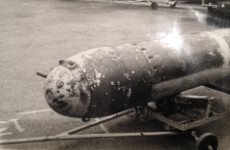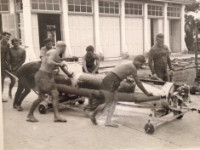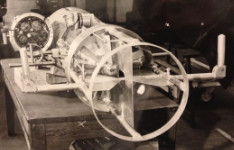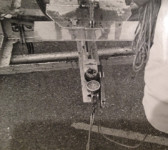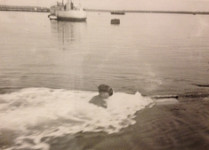 British SBS Archimedes swimmer delivery vehicle
British SBS Archimedes swimmer delivery vehicle
 When World War Two came to a close British frogmen were at the forefront of underwater special forces tactics and training. The Royal Marines’ Special Forces units which evolved into the postwar SBS (Special Boat Squadron) had developed diving operations from Canoes (‘Swimmer Canoeist’), paddle boards, X-Craft and the ‘Sleeping Beauty’ Motorised Submersible Canoe (MSC). These capabilities were generally maintained and developed post-war, albeit on a smaller scale.
When World War Two came to a close British frogmen were at the forefront of underwater special forces tactics and training. The Royal Marines’ Special Forces units which evolved into the postwar SBS (Special Boat Squadron) had developed diving operations from Canoes (‘Swimmer Canoeist’), paddle boards, X-Craft and the ‘Sleeping Beauty’ Motorised Submersible Canoe (MSC). These capabilities were generally maintained and developed post-war, albeit on a smaller scale.
During the undeclared war between Indonesia and Malaysia in 1963-66 (known as the Indonesia Confrontation), British forces protected Malaysia and Singapore. An official requirement was raised for the Royal Marine’s Special Forces unit, the SBS, to be ready to conduct underwater sabotage missions against enemy ships in harbor. This required a covert means for the combat swimmers to approach the targets, which led to the Archimedes.

By this time the Sleeping Beauty submersible canoes were worn out. A few were still used for research until the early 1960s but they had not been built for long service and were no longer viable. There had been no serious efforts to replace them. Chariots had never been a Marines vehicle and were also much too long in the tooth. The unique Baptism single-diver tug was still a one-off research vehicle, and although cutting-edge for beach reconnaissance, would not have been suitable for ship attack. A new vehicle was urgently required.
1. 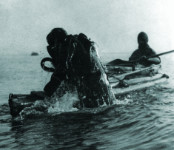 2.
2.  3.
3. 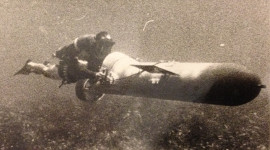
1. SBS swimmer canoeist pair. Liable to detection by radar.
2. MSC being tested with added bow planes, early 1960s.
3. Baptism being tested by SBS, Malta, 1966. Photo 1 via Special Boat Service Association (SBSA), photos 2 & 3 KR Tuson collection, Historical Diving Society.
Archimedes, also known as “Archie”, was ready for the SBS in early 1966. It was a Heath Robinson affair, fashioned out of a spare Mk.20 Bidder anti-submarine torpedo by Royal Navy engineers at the Hong Kong depot. Rather than sitting astride the torpedo like the earliest Chariots, it was decided to place the swimmers laying prone either side almost behind the machine. This arrangement may have been influenced by the single-man tugs of the time but it was much bigger. The men lay at the stern so an additional guard had to be added to protect them from the propeller and control surfaces. Like the original Chariot all the control surfaces were at the stern which would have significantly hampered maneuverability. It was a challenge to drive but gave the SBS valuable experience in handling underwater vehicles. Forward hydroplanes were considered but it was not practical to add them due to the construction of the torpedo and position of the crew.
Photos from KR Tuson collection, Historical Diving Society.
The driver was on the port (left) side with a large sealed cylinder ahead of him for the rudimentary instrumentation. A crossbar at the rear rose between their legs, acting to stop them sliding off the back of the craft as it accelerated through the water. Except the instrument panel in front of the driver no protection was afforded against the oncoming water which limited forward speed to about 3kt. Unsurprisingly Archimedes used the batteries from the Mk20 torpedo which gave it a theoretical endurance of 3 hours but in reality it was closer to 2.5kt. This was not really a problem since the craft had no onboard breathing air so the crew had to conduct the whole mission using their own breathing sets. Several configurations were tested with the Clearance Diver Breathing Apparatus (CBDA) proving the longest endurance and deepest diving. Breathing gas could be conserved by running on the surface using snorkels, but the lack of a wave break made this incredibly uncomfortable for the crew in a Force 4 wind and slight swell, and impossible above that.
First two photos from KR Tuson collection, Historical Diving Society, third via Special Boat Service Association (SBSA).
Despite its limitations the SBS in the Far East were quite enthusiastic about Archimedes, at least on the basis that something was better than nothing, and that it demonstrated the requirement to the bureaucrats at home. Reports circulated in the UK suggested that Archimedes represented an operational capability, but this was overstating the facts.
The ultimate book of Special Forces subs Covert Shores 2nd Edition is the ONLY world history of naval Special Forces, their missions and their specialist vehicles. SEALs, SBS, COMSUBIN, Sh-13, Spetsnaz, Kampfschwimmers, Commando Hubert, 4RR and many more.
Check it out on Amazon
One problem that remained was how to get the Archimedes into position to launch the mission. The design had the backing of the head of the Southern Submarine Squadron (SM7) Capt. John Moore and was intended to be operated from submarines but development of this capability was slow. The SBS generally used Royal Navy minesweepers to ferry them around but the Archimedes was heavy and cumbersome while the minesweepers were large, slow and poorly armed for the job. More crucially, ferrying SBS was not their primary mission and if push came to shove the mine countermeasures role would trump the SBS’ modest needs so they would be left without transport. The other tactically credible way of launching an SDV is from the casing of a submarine while it is submerged...
Photos from KR Tuson collection, Historical Diving Society.
Fortunately there were still some vintage A-Class submarines deployed in the Far East which had been built at a time when submarines still had guns, which required a large capacity ‘gun-tower’ lock-out chamber. By this time the guns were rarely fitted and these lock-out chambers repurposed for submarine escape, but they were bigger than the ones being fitted to the newer submarines; big enough for two divers with breathing apparatus. Exit and reentry was from the escape hatch in the gun tower, just forward of the fin. Initial trials from HMS Alliance were organized and led by the SBS with Clearance Divers also taking part.
Unusually some senior naval officers in the region were almost as enthusiastic about the trials as the SBS and they certainly received significant help from the Royal Navy getting things going. In particular, Capt. John Moore took a special interest to secure equipment and even participated in some aspects of the trials himself. He was unusual among submariners to be very supportive of special operations although his motivation was to find ways to reduce the risks faced by the submarines on those types of mission. From his perspective, the reason to conduct underwater exit and re-entry was to avoid having to surface the submarine near to the enemy. Moore had also used his contacts to acquire the torpedo for the SBS’ Archimedes SDV. A very remarkable man, Moore went on to be an Editor at the famous Defense Intelligence publication Jane’s.
Get The essential guide to World Submarines
This Covert Shores Recognition Guide Covers over 80 classes of submarines including all types currently in service with World Navies.Check it out on Amazon
In 1967 a demonstration was arranged to show off the Archimedes SDV. Predictably the craft sprung a leak and sunk in 140ft (40m) of water. It was recovered but the demonstration had served its purpose; rather than dismissing their efforts, the Commander in Chief took it as proof that real investment was needed. A formal requirement for a “Swimmer Delivery Vehicle” (SDV) was raised.
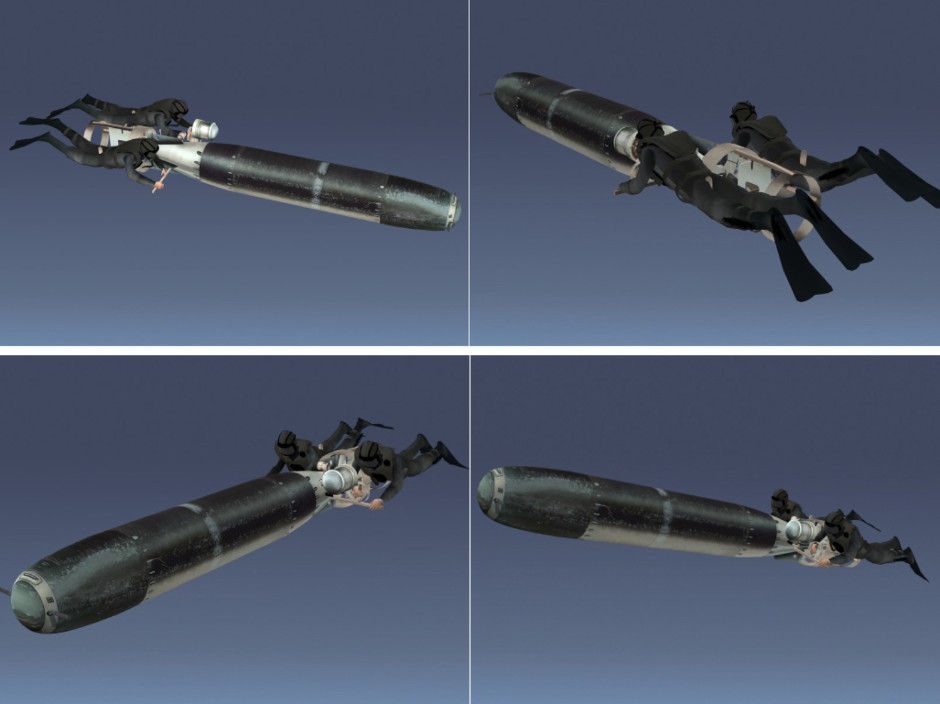
3D model by Landino Luca
Related articles (Full index of popular Covert Shores articles)

 British SDV developmemts in 1960s (Dick Tuson)
British SDV developmemts in 1960s (Dick Tuson)
 Sleeping Beauty (Motorised Submersible Canoe) of WW2
Sleeping Beauty (Motorised Submersible Canoe) of WW2

 Mignatta first human torpedo
Mignatta first human torpedo

 Stidd Diver Propulsion Device (DPD)
Stidd Diver Propulsion Device (DPD)


 Dry Combat Submersible (DCS)
Dry Combat Submersible (DCS)

 SDV Mk.9 SEAL Delivery Vehicle. w/Cutaway
SDV Mk.9 SEAL Delivery Vehicle. w/Cutaway

 DGSE's SDVs
DGSE's SDVs

 Cos.Mo.S CE2F chariot
Cos.Mo.S CE2F chariot

 SWUV (/ PSM3G) advanced SDV
SWUV (/ PSM3G) advanced SDV

 Naval Spetsnaz in Hybrid Warfare (Russian SDVs and DPVs)
Naval Spetsnaz in Hybrid Warfare (Russian SDVs and DPVs)

 SubSEAL advanced SDV
SubSEAL advanced SDV

 SubCat SDV
SubCat SDV


 Marex Type-A (A2, A4, A5, Comex Total-Sub-01) SDVs
Marex Type-A (A2, A4, A5, Comex Total-Sub-01) SDVs

 Polish Blotniak SDV
Polish Blotniak SDV


 EMT FWS-1 to -5 Barracuda SDVs
EMT FWS-1 to -5 Barracuda SDVs


